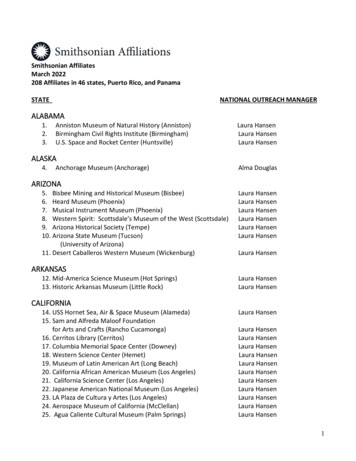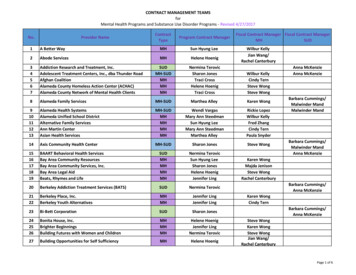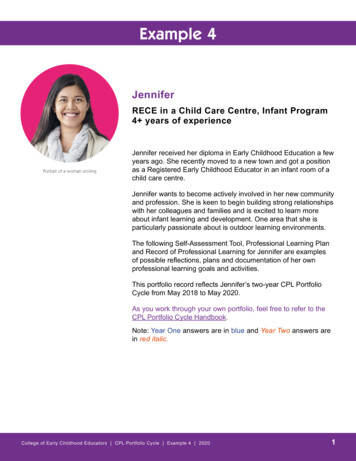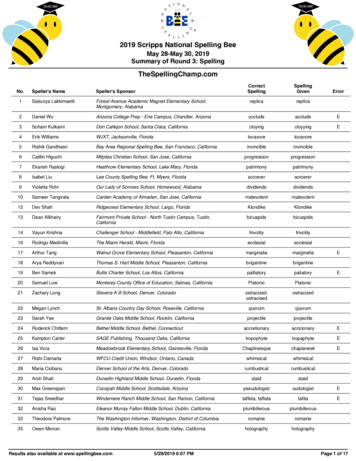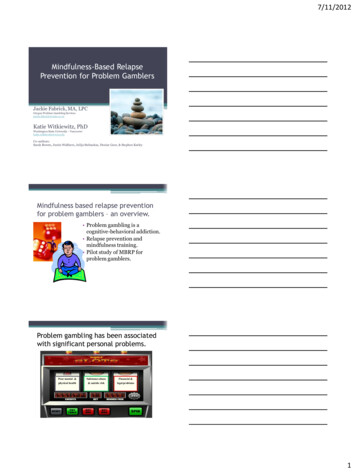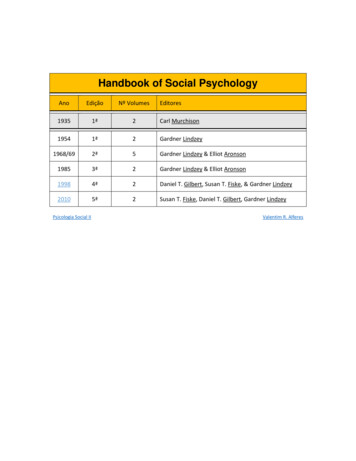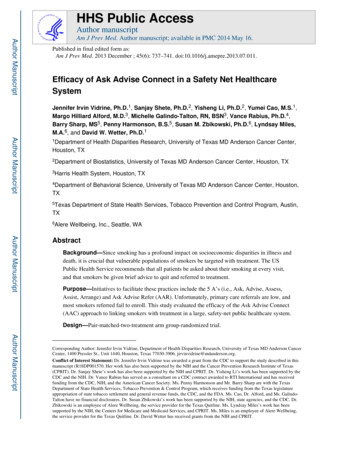
Transcription
HHS Public AccessAuthor manuscriptAuthor ManuscriptAm J Prev Med. Author manuscript; available in PMC 2014 May 16.Published in final edited form as:Am J Prev Med. 2013 December ; 45(6): 737–741. doi:10.1016/j.amepre.2013.07.011.Efficacy of Ask Advise Connect in a Safety Net HealthcareSystemJennifer Irvin Vidrine, Ph.D.1, Sanjay Shete, Ph.D.2, Yisheng Li, Ph.D.2, Yumei Cao, M.S.1,Margo Hilliard Alford, M.D.3, Michelle Galindo-Talton, RN, BSN3, Vance Rabius, Ph.D.4,Barry Sharp, MS5, Penny Harmonson, B.S.5, Susan M. Zbikowski, Ph.D.6, Lyndsay Miles,M.A.6, and David W. Wetter, Ph.D.1Author Manuscript1Departmentof Health Disparities Research, University of Texas MD Anderson Cancer Center,Houston, TX2Department3Harrisof Biostatistics, University of Texas MD Anderson Cancer Center, Houston, TXHealth System, Houston, TX4Departmentof Behavioral Science, University of Texas MD Anderson Cancer Center, Houston,TX5TexasDepartment of State Health Services, Tobacco Prevention and Control Program, Austin,TX6AlereWellbeing, Inc., Seattle, WAAuthor ManuscriptAbstractBackground—Since smoking has a profound impact on socioeconomic disparities in illness anddeath, it is crucial that vulnerable populations of smokers be targeted with treatment. The USPublic Health Service recommends that all patients be asked about their smoking at every visit,and that smokers be given brief advice to quit and referred to treatment.Purpose—Initiatives to facilitate these practices include the 5 A’s (i.e., Ask, Advise, Assess,Assist, Arrange) and Ask Advise Refer (AAR). Unfortunately, primary care referrals are low, andmost smokers referred fail to enroll. This study evaluated the efficacy of the Ask Advise Connect(AAC) approach to linking smokers with treatment in a large, safety-net public healthcare system.Design—Pair-matched-two-treatment arm group-randomized trial.Author ManuscriptCorresponding Author: Jennifer Irvin Vidrine, Department of Health Disparities Research, University of Texas MD Anderson CancerCenter, 1400 Pressler St., Unit 1440, Houston, Texas 77030-3906. jirvinvidrine@mdanderson.org.Conflict of Interest Statement: Dr. Jennifer Irvin Vidrine was awarded a grant from the CDC to support the study described in thismanuscript (R18DP001570. Her work has also been supported by the NIH and the Cancer Prevention Research Institute of Texas(CPRIT). Dr. Sanjay Shete’s work has also been supported by the NIH and CPRIT. Dr. Yisheng Li’s work has been supported by theCDC and the NIH. Dr. Vance Rabius has served as a consultant on a CDC contract awarded to RTI International and has receivedfunding from the CDC, NIH, and the American Cancer Society. Ms. Penny Harmonson and Mr. Barry Sharp are with the TexasDepartment of State Health Services, Tobacco Prevention & Control Program, which receives funding from the Texas legislatureappropriation of state tobacco settlement and general revenue funds, the CDC, and the FDA. Ms. Cao, Dr. Alford, and Ms. GalindoTalton have no financial disclosures. Dr. Susan Zbikowski’s work has been supported by the NIH, state agencies, and the CDC. Dr.Zbikowski is an employee of Alere Wellbeing, the service provider for the Texas Quitline. Ms. Lyndsay Miles’s work has beensupported by the NIH, the Centers for Medicare and Medicaid Services, and CPRIT. Ms. Miles is an employee of Alere Wellbeing,the service provider for the Texas Quitline. Dr. David Wetter has received grants from the NIH and CPRIT.
Vidrine et al.Page 2Setting/participants—Ten safety-net clinics in Houston, TX.Author ManuscriptIntervention—Clinics were randomized to AAC (n 5; intervention) or AAR (n 5; control).Licensed Vocational Nurses (LVNs) were trained to assess and record the smoking status of allpatients at all visits in the electronic health record (EHR). Smokers were given brief advice to quit.In AAC, the names and phone numbers of smokers who agreed to be connected were sentelectronically to the Texas Quitline daily, and patients were proactively called within 48 hours. InAAR, smokers were offered a Quitline referral card and encouraged to call on their own. Datawere collected between June 2010 and March 2012 and analyzed in 2012.Main Outcome Measure—The primary outcome – impact – was defined as the proportion ofidentified smokers that enrolled in treatment.Author ManuscriptResults—The impact (proportion of identified smokers who enrolled in treatment) of AAC(14.7%) was significantly greater than the impact of AAR (0.5%), t (4) 14.61, p 0.0001, OR 32.10 (95% CI 16.60–62.06).Conclusions—AAC has tremendous potential to reduce tobacco-related health disparities.BACKGROUNDAuthor ManuscriptSmoking is becoming increasingly concentrated among individuals with the lowest levels ofeducation, income, and occupational status,1–6 and has a profound impact on socioeconomicdisparities in the United States.7–9 Therefore, it is crucial that vulnerable populations ofsmokers be targeted with evidence-based cessation treatment.10 Because evidence-basedtreatments delivered by quitlines are underutilized,11–1510,16 formalizing partnerships withhealthcare systems has been identified as a critical strategy for enhancing their reach andoverall impact.16 Despite 5 A’s (i.e., Ask, Advise, Assess, Assist, Arrange) and “Ask AdviseRefer (AAR)” initiatives,121117181920 treatments have not been well integrated withinhealthcare systems.10,16,21–24 Thus, there is a critical need to address treatment barriers. Werecently evaluated the efficacy of a new, electronic health record (EHR)-based approach toconnect smokers in healthcare settings with treatment called “Ask Advise Connect” (AAC).Results of our initial trial, conducted in a private healthcare system, indicated that AAC (vs.AAR) was associated with a 13-fold increase in treatment enrollment.25 The current studyutilized similar methodology and was intended to replicate the findings in a safety-nethealthcare system.METHODSStudy DesignAuthor ManuscriptA pair-matched group randomized design in 10 Harris Health System community healthclinics was utilized. The clinics serve nearly 200,000 unique adult patients per year, 90% aremembers of racial/ethnic minority groups, and nearly half have incomes below poverty. Fiveclinics were randomized to AAC (intervention) and five were randomized to AAR (controlcondition). The dissemination period was 18 months. Data were collected between June2010 and March 2012 and analyzed in 2012. The protocol was published in 2010.26Am J Prev Med. Author manuscript; available in PMC 2014 May 16.
Vidrine et al.Page 3ParticipantsAuthor ManuscriptParticipants were current smokers 18 who were seen the clinics. There was no racial orgender bias in participant selection. IRB approval was obtained from MD Anderson CancerCenter, Harris Health System, and the Texas Department of State Health Services.RandomizationRandomization occurred at the clinic level. Clinics were initially paired by the investigatorsbased on patient volume, average age, gender, race/ethnicity, and percent below poverty.One clinic within each pair was then randomly assigned to one of the two arms.ProceduresAuthor ManuscriptIn AAC and AAR, Licensed Vocational Nurses (LVNs) were trained to assess and recordthe smoking status of all patients at all visits in the EHR when vital signs were collected.They were also trained to provide smokers with brief advice to quit consistent with theGuideline.11 A 30-minute training session on how to assess smoking status, deliver briefadvice to quit, and connect (AAC) or refer (AAR) patients to the Quitline was held at thebeginning of the trial. In AAC, LVNs directly connected patients with the Quitline throughclicking an automated link in the EHR that sent smokers’ names and phone numbers to theresearch team, who then sent the information to the Quitline within 24 hours. Patients werecontacted by the Quitline within 48 hours. In AAR, LVNs gave smokers willing to acceptassistance a Quitline referral card.Author ManuscriptSmoking status and willingness to be connected (in AAC) or referred (in AAR) wererecorded using the EHR. An Excel data file was automatically and securely sent to theresearch team daily, and forwarded to the Quitline daily. Treatment enrollment was trackedand recorded by the Quitline. Data were maintained in an Access database.Outcome Measures: Reach, Efficacy and ImpactReach, efficacy, and impact were evaluated using the RE-AIM framework.27 Reach number of smokers that talked with Quitline / total number of identified smokers. Efficacy number of smokers that enrolled in Quitline treatment / total number of identified smokersthat talked with Quitline. Impact Reach Efficacy.Data AnalysisAuthor ManuscriptProportions for Reach, Efficacy, and Impact were calculated and the magnitude andsignificance of differences between AAC and AAR were evaluated using Donner andDonald’s weighted empirical logistic transformation approach. This approach accounts fornesting of individuals within clinics and induced intraclass correlation and was used becausethe data were generated using a pair-matched-two-treatment arm group randomized trial.28This method accounts for the probability of imbalance between treatment groups onparticipant characteristics, and provides estimated odds ratios (ORs) for assessing thesignificance of the intervention effects over all strata.Am J Prev Med. Author manuscript; available in PMC 2014 May 16.
Vidrine et al.Page 4Author ManuscriptRESULTSSmoking prevalence was 16.0% (17,959 / 112,112), and higher in AAC (7,237 / 40,402 17.9%) versus AAR (10,722 / 70,710 15.2%), Pearson’s X2(1) 142.8 p 1.3 10 33.However, Donner and Donald’s 22 approach accounts for such imbalances and yields resultsrobust to such potential biases.ReachAuthor ManuscriptIn AAC, 7,237 smokers were identified, and in AAR, 10,722 smokers were identified. InAAC, 23.6% of identified smokers talked with the Quitline (1,707 / 7,237) and in AAR,0.5% of identified smokers talked with the Quitline (56 / 10,722). The empirical logistictransformation approach indicated that the Reach was significantly greater in AAC (vs.AAR), t(4) 18.60, p .00005.28 The overall estimated odds ratio (OR) and 95% CI forassessing the intervention on Reach over all strata was equal to 56.19 (95% CI 30.79–102.53).EfficacyOf the 1,707 smokers that talked with the Quitline in AAC, 1,060 enrolled in treatment(62.1% enrollment rate). Of the 56 smokers in AAR that talked with the Quitline, 53enrolled in treatment (94.6% enrollment rate). The unconditional test for equivalence of twobinomial proportions was used to compare treatment enrollment in AAR versus AAC. TheEfficacy of AAR (vs. AAC) was significantly greater (standardized Z statistic 4.97,p 3.4 10 7.).ImpactAuthor ManuscriptImpact was significantly greater in AAC (23.6% 62.1% 14.7%) than in AAR (0.5% 94.6% 0.5%), t (4) 14.61, p 0.0001.28 The overall estimated OR for assessing theeffect of the intervention on impact over all strata was equal to 32.10 (95% CI 16.60–62.06).CONCLUSIONSAuthor ManuscriptDirectly connecting low-income, racially/ethnically diverse smokers to the Quitline via anautomated link in the EHR resulted in a nearly 30-fold increase in treatment enrollmentcompared to providing referral cards and asking smokers to call on their own. This treatmentenrollment rate is larger than in any study previously reported. Importantly, AAC yielded alarger effect size in a safety-net healthcare system than a private healthcare system (30-foldvs. 13-fold increase in treatment enrollment).25 Recent healthcare reform legislation hascreated an environment in which programs such as AAC could be integrated and sustainedwithin healthcare settings.29–31A strength is that AAC was evaluated in a setting representative of real-world healthcaresystems that serve smokers disproportionately burdened by tobacco. Additionally, AACcould be implemented broadly in other healthcare settings. A limitation is that smokingoutcome data were not collected, and smokers who called the Quitline may have been moremotivated to quit. Another limitation is the absence of a fidelity check on LVNs. ThatAm J Prev Med. Author manuscript; available in PMC 2014 May 16.
Vidrine et al.Page 5Author Manuscriptsmoking prevalence (16%) was lower than would be expected in this population, anddiffered between AAC (17.9%) and AAR (15.0%) clinics, suggests that all patients were notfor smoking status, and that AAC (vs. AAR) clinics may have more systematically screenedand documented smoking status. Finally, the national infrastructure for supporting quitlineswould need to be expanded to be sufficient to support widespread adoption of AAC.In summary, widespread adoption of AAC could reduce tobacco-related morbidity andmortality, and the large effect obtained in a safety-net healthcare system supports thepotential of AAC to reduce tobacco-related health disparities.AcknowledgementsAuthor ManuscriptThe project described was supported by Grant Number R18DP001570 (PI: Vidrine) from the Centers for DiseaseControl and Prevention (CDC). Its contents are solely the responsibility of the authors and do not necessarilyrepresent the official views of the CDC. This work was also partially supported by the National Institutes of Healththrough MD Anderson's Cancer Center Support Grant CA016672. MD Anderson’s Patient-Reported Outcomes,Survey, and Population Research (PROSPR) Shared Resource also provided support through MD Anderson’sCancer Center Support Grant. Support was also provided by a grant from The University of Texas MD AndersonCancer Center Duncan Family Institute for Cancer Prevention and Risk Assessment - Center for CommunityEngaged Translational Research.REFERENCESAuthor ManuscriptAuthor Manuscript1. CDC. Cigarette smoking among adults - Unites States, 2000. MMWR. 2002; 51:642–645. [PubMed:12186222]2. Wetter DW, Cofta-Gunn L, Fouladi RT, et al. Understanding the associations among education,employment characteristics, and smoking. Addict Behav. 2005; 30:905–914. [PubMed: 15893088]3. Barbeau EM, Krieger N, Soobader MJ. Working class matters: socioeconomic disadvantage, race/ethnicity, gender, and smoking in NHIS 2000. Am J Public Health. 2004; 94:269–278. [PubMed:14759942]4. CDC. Cigarette smoking among adults-United States, 2003. MMWR Morb Mortal Wkly Rep. 2005;54:509–513. [PubMed: 15917735]5. Hughes JR. The future of smoking cessation therapy in the United States. Addiction. 1996;91:1797–1802. [PubMed: 8997761]6. Winkleby MA. Accelerating cardiovascular risk factor changes in ethnic minority and lowsocioeconomic groups. Annals of Epidemiology. 1997; S7:S96–S103.7. Pierce JP, Fiore MC, Novotny TE, Hatziandreu EJ, Davis RM. Trends in cigarette smoking in theUnited States. Educational differences are increasing. Jama. 1989; 261:56–60. [PubMed: 2908995]8. Fiore MC, Novotny TE, Pierce JP, Hatziandreu EJ, Patel KM, Davis RM. Trends in cigarettesmoking in the United States. The changing influence of gender and race. Jama. 1989; 261:49–55.[PubMed: 2908994]9. Honjo K, Tsutsumi A, Kawachi I, Kawakami N. What accounts for the relationship between socialclass and smoking cessation? Results of a path analysis. Soc Sci Med. 2006; 62:317–328. [PubMed:16039765]10. Abrams, DB. A comprehensive smoking cessation policy for all smokers: Systems integration tosave lives and money. In: Bonnie, RJ.; Stratton, K.; Wallace, RB., editors. Ending the TobaccoProblem: A Blueprint for the Nation. Washington, D.C.: Institute of Medicine: NationalAcademies Press; 2007. Appendix A11. Fiore, MC.; Jaen, CR.; Baker, TB., et al. Treating Tobacco Use and Dependence: 2008 Update.Rockville, MD: U.S. Department of Health and Human Services (USDHHS), Public HealthService (PHS); 2008.12. Fiore, MC.; Bailey, WC.; Cohen, SJ., et al. Treating Tobacco Use and Dependence: ClinicalPractice Guideline. Rockville, MD: U.S. Department of Health and Human Services (USDHHS),Public Health Service (PHS); 2000. Report No.: 1-58763-007-9.Am J Prev Med. Author manuscript; available in PMC 2014 May 16.
Vidrine et al.Page 6Author ManuscriptAuthor ManuscriptAuthor ManuscriptAuthor Manuscript13. Stead, LF.; Perera, R.; Lancaster, T. Telephone counseling for smoking cessation (review). NewYork: John Wiley & Sons; 2007.14. Ossip-Klein DJ, McIntosh S. Quitlines in North America: evidence base and applications. Am JMed Sci. 2003; 326:201–205. [PubMed: 14557735]15. Rabius V, McAlister AL, Geiger A, Huang P, Todd R. Telephone counseling increases cessationrates among young adult smokers. Health Psychol. 2004; 23:539–541. [PubMed: 15367074]16. Borland R, Segan CJ. The potential of quitlines to increase smoking cessation. Drug Alcohol Rev.2006; 25:73–78. [PubMed: 16492579]17. Ask and Act Tobacco Cessation Program. 2013 at health/tobacco.html.18. Bernstein SL, Boudreaux ED, Cydulka RK, et al. Tobacco control interventions in the emergencydepartment: a joint statement of emergency medicine organizations. Ann Emerg Med. 2006;48:e417–e426. [PubMed: 16997678]19. ASA Stop Smoking Initiative for Providers: Smoke-Free for Surgery. at on/ASA-Stop-Smoking-Initiative.aspx.20. Do you cAARd? Ask, Advise, Refer - Help your patients quit smoking. 2006 at http://www.caldiabetes.org/content display.cfm?contentID 497&CategoriesID 32.21. Bentz CJ, Bayley KB, Bonin KE, Fleming L, Hollis JF, McAfee T. The feasibility of connectingphysician offices to a state-level tobacco quit line. Am J Prev Med. 2006; 30:31–37. [PubMed:16414421]22. Solberg LI, Maciosek MV, Edwards NM, Khanchandani HS, Goodman MJ. Repeated tobacco-usescreening and intervention in clinical practice: health impact and cost effectiveness. Am J PrevMed. 2006; 31:62–71. [PubMed: 16777544]23. Katz DA, Muehlenbruch DR, Brown RB, Fiore MC, Baker TB. Effectiveness of a clinic-basedstrategy for implementing the AHRQ Smoking Cessation Guideline in primary care. Prev Med.2002; 35:293–301. [PubMed: 12202073]24. Conroy MB, Majchrzak NE, Silverman CB, et al. Measuring provider adherence to tobaccotreatment guidelines: a comparison of electronic medical record review, patient survey, andprovider survey. Nicotine Tob Res. 2005; 7(Suppl 1):S35–S43. [PubMed: 16036268]25. Vidrine JI, Shete S, Cao Y, et al. Ask-Advise-Connect: a new approach to smoking treatmentdelivery in health care settings. JAMA Intern Med. 2013; 173:458–464. [PubMed: 23440173]26. Vidrine JI, Rabius V, Alford MH, Li Y, Wetter DW. Enhancing dissemination of smokingcessation quitlines through T2 translational research: a unique partnership to address disparities inthe delivery of effective cessation treatment. J Public Health Manag Pract. 2010; 16:304–308.[PubMed: 20520368]27. Glasgow RE, Vogt TM, Boles SM. Evaluating the public health impact of health promotioninterventions: The RE-AIM framework. American Journal of Public Health. 1999; 89:1322–1327.[PubMed: 10474547]28. Donner A, Donald A. Analysis of data arising from a stratified design with the cluster as unit ofrandomization. Statistics in medicine. 1987; 6:43–52. [PubMed: 3576016]29. Patient Protection and Affordable Care Act. HR-3590 United States. 200930. Health Information Technology for Economic and Clinical Health. Title XIII of Division A andTitle IV of Division B United States. 200931. Buntin MB, Jain SH, Blumenthal D. Health information technology: laying the infrastructure fornational health reform. Health Aff (Millwood). 2010; 29:1214–1219. [PubMed: 20530358]Am J Prev Med. Author manuscript; available in PMC 2014 May 16.
Vidrine et al.Page 7Author ManuscriptAuthor ManuscriptAuthor ManuscriptFigure 1.CONSORT Flow DiagramAuthor ManuscriptAm J Prev Med. Author manuscript; available in PMC 2014 May 16.
Vidrine et al.Page 8Author ManuscriptAuthor ManuscriptAuthor ManuscriptAuthor ManuscriptFigure 2.Reach, Efficacy, and Impact for AAC and AARNotes: Reach proportion of smokers identified who talked with Quitline; Efficacy proportion of smokers who talked with Quitlline that enrolled in treatment; Impact Reach EfficacyAm J Prev Med. Author manuscript; available in PMC 2014 May 16.
Zbikowski is an employee of Alere Wellbeing, the service provider for the Texas Quitline. Ms. Lyndsay Miles's work has been supported by the NIH, the Centers for Medicare and Medicaid Services, and CPRIT. Ms. Miles is an employee of Alere Wellbeing, the service provider for the Texas Quitline. Dr.
